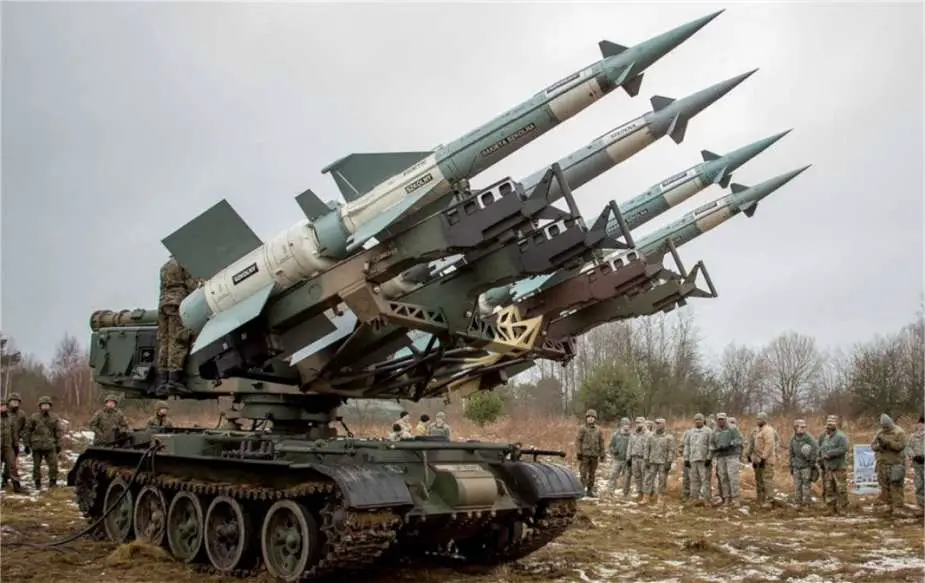Breaking news
Poland Discusses Boosting Ukraine's Air Defense with Soviet-Era Missiles from its military stocks.
During an international summit that was held in Lithuania on April 11, 2024, Polish President Andrzej Duda revealed discussions with Ukrainian President Volodymyr Zelensky regarding the potential transfer of Soviet-made air defense missile systems to bolster Ukraine's air defense capabilities. This announcement came amidst a significant increase in Russian military aggression, particularly targeting energy facilities and civilian infrastructure across Ukraine.
Follow Army Recognition on Google News at this link

Polish army S-125 Newa SC surface-to-air defense missile system. (Picture source Interia.pl)
According to President Duda, the talks, which also involved Lithuanian President Gitanas Nauseda, focused on strengthening Ukraine's defensive posture as Russian forces ramp up their assault. "We discussed the possibility of transferring them (Soviet-made missiles) to Ukraine in order to provide air defense," Duda stated during a press conference held with Presidents Zelensky and Nauseda.
The discussions are timely as the Ukrainian Interior Ministry reports a sharp rise in Russian strikes, with approximately 30,000 attacks recorded over the past three months alone. These attacks have largely concentrated on debilitating the Ukrainian energy sector and wreaking havoc on civilian areas, escalating the humanitarian crisis in the region.
The potential missile transfer underscores a broader regional effort to support Ukraine in its defense against the ongoing Russian invasion. Details regarding the types of missiles and the timeline for the transfer remain under discussion, with further consultations expected as the situation develops.
Currently, the Polish armed forces are equipped with 17 S-125 Newa SC, a modernized variant of the Soviet-era SA-3 Goa air defense missile system. According to open-source information, Ukraine has already received an undisclosed number of this air defense missile system from Poland.
The S-125 Neva/Pechora, known in NATO as the SA-3 Goa, is a Soviet-designed surface-to-air missile system developed during the Cold War for low to medium-altitude air defense. First operational in 1961, it was designed as a complement to higher altitude systems like the S-75 (SA-2). The S-125 has seen various upgrades over the decades, including digital enhancements and mobility improvements such as mounting on different vehicle chassis.
The missile of the S-125 can engage aerial targets at an altitude from 20 to 18,000 meters, with an effective range of approximately 3.5 to 25 kilometers. This makes it suitable for defending against low-flying threats, but less effective against high-altitude or high-speed targets like ballistic missiles.
The Polish S-125 Newa SC is a modernized version of the Soviet-era S-125 Neva-M anti-aircraft missile system. The modernization, which has been implemented in two stages, involved significant upgrades to enhance the system's mobility, radar capabilities, and overall effectiveness in engaging aerial targets. The first phase of the modernization, initiated in 1992, included mounting the launcher on a T-55 tank chassis and installing the radar system on a wheeled chassis from the Scud missile system. This transformed the S-125 into a self-propelled system, significantly increasing its mobility.
Further enhancements in 1996 included the replacement of many components with modern electronics, adding two processors to improve target tracking and resistance to radar jamming. These upgrades allowed the system to detect targets under challenging conditions and increased its target detection range, although the missile's range remained unchanged due to limitations of the propulsion system. The modernization efforts also reduced the crew needed to operate the system by half, streamlined its service requirements, and equipped it with its own IFF (Identification Friend or Foe) system under a Thomson-CSF license.
The Newa SC variant has been noted for its digital systems that replace many of the analog components of the older versions, enhancing reliability and accuracy. This variant has been actively used, including recent deployments by Ukrainian forces as part of their air defense setup against modern threats, though it remains a system primarily effective against low to medium-altitude targets.
Poland has been a significant contributor to military aid for Ukraine, playing a leading role in Europe's response to the ongoing conflict. Since the onset of the war, Poland has been at the forefront in providing various forms of assistance including military hardware, financial support, and humanitarian aid. As of early 2024, Poland proposed the creation of a 20-billion-euro fund to further support Ukraine's military needs over the next four years. This proposal is part of broader efforts by the EU to enhance its collective military support, although it has faced some resistance from other member states regarding the commitment of funds in advance.
Poland's contributions are not just about funding; they have also included substantial supplies of military equipment. The country has been pivotal in logistics, helping to channel support from other nations as well. This level of support underscores Poland's strategic role on NATO's eastern flank and highlights its ongoing commitment to Ukraine’s defense capabilities against the backdrop of the Russian invasion of Ukraine.
Defense News April 2024























